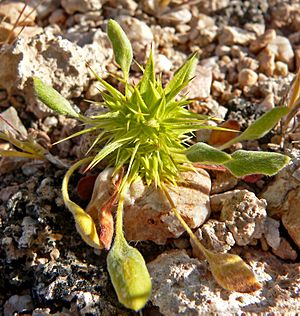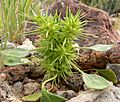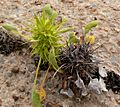Chorizanthe rigida facts for kids
Quick facts for kids Chorizanthe rigida |
|
|---|---|
 |
|
| Scientific classification | |
| Genus: |
Chorizanthe
|
| Species: |
rigida
|
The devil's spineflower (scientific name: Chorizanthe rigida) is a cool plant that grows every year. It's part of the buckwheat family, called Polygonaceae. This plant is also known as the rigid spineflower or spiny-herb. You can find it in the southwestern United States and parts of Mexico, like California, Nevada, Utah, Arizona, Baja California, and Sonora. It's a type of Chorizanthe, which are often called spineflowers because of their spiky look!
Where Does the Devil's Spineflower Grow?
The devil's spineflower is a common plant found in the Sonoran and Mojave Deserts. It likes to grow in places like washes (which are dry riverbeds), flat areas called mesas that get flooded when it rains, and rocky hillsides. For example, you can find it in many parts of the Muggins Mountains Wilderness in Arizona.
Sometimes, in flat desert areas, this short plant (only about 3 inches tall) can get covered by dirt and plant bits that wash downstream. These bits can pile up around the spineflower's dry skeleton. This might actually help new spineflowers grow in the same spot later on!
On flat mesas, the plant can be hidden under clumps of other plants. But along roadsides, you might see its dry skeleton standing tall by itself. The tallest plants usually grow where water collects the most. In the eastern Colorado Desert, you can spot this plant in most major washes during mid-spring, especially after good winter rains.
What Does the Devil's Spineflower Look Like?
The Chorizanthe rigida plant is usually short and stands upright. It can have one main stem or up to five (or more!) stems. It grows quickly, especially after spring rains. It can reach a height of about 2.5 to 6 inches (6 to 15 cm).
This plant has a main taproot, which is a long, thick root that grows straight down. This root is often longer than the plant itself! It helps the plant find and use the moisture deep in the ground from rainfall.
When the devil's spineflower is growing and healthy, it's a bright green color, making it easy to spot. But when summer arrives and the plant dries out, it turns into a spiky skeleton. This skeleton can be blackish, dark gray, or medium brown. It blends in very well with the desert ground, making it hard to see!
In the hottest parts of the western Sonoran Desert in Arizona, the rigid spineflower is often only 2.5 to 5 inches tall. Because it's so small and blends in when dry, people often don't even notice it!
Images for kids





